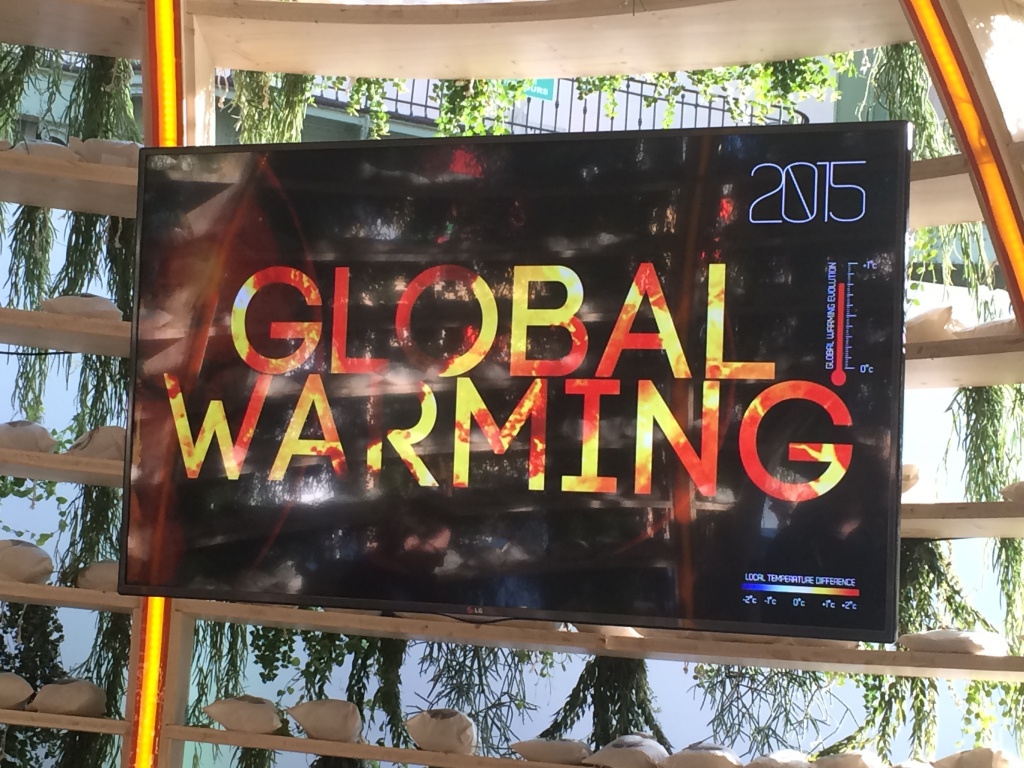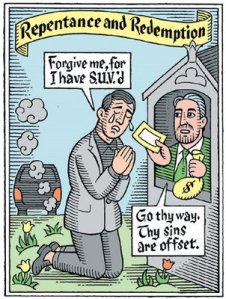This four-part post originally appeared on the Net Impact Boston blog.
- Part 1: COP21: The UN Climate Change Conference
- Part 2: COP21: Why This Year is Different
- Part 3: My Impressions from COP21
- Part 4: What’s In the Paris Agreement?
THIRTY-TWO pages.
In case you were wondering how many pages it takes for an international agreement among 196 countries to change the fate of the world, the Paris Agreement is a mere 32 pages. In comparison, the TI-89 graphing calculator sitting in my desk drawer like an old war medal from my engineering days has a manual of 1,008 pages; page 32 is halfway through its “Getting Started” section.
The Paris Agreement is beautiful in its simplicity, matching the reality of our global condition: we have to reduce our carbon emissions or else. The Agreement was signed on December 12, 2015 and is set to take effect today, Earth Day, the 22nd of April 2016 in a signing ceremony at the UN. I’ll do my best to explain it here with matching brevity and clarity.
A Pithy Preamble
The Paris Agreement starts with the clear and compelling case that “climate change represents an urgent and potentially irreversible threat to human societies and the planet and thus requires the widest possible cooperation by all countries, and their participation in an effective and appropriate international response, with a view to accelerating the reduction of global greenhouse gas emissions.”
There’s a lot packed into this opening salvo. Climate change is an urgent and potentially irreversible: if we don’t act now, we may never be able to alter its course. We are, as Carl Sagan is often attributed as saying, “by accident of fate alive at an absolutely critical moment in the history of our planet.”
It is a threat first to human societies: although with a species extinction rate of 1,000 times the background rate, many scientists believe that we’re currently experiencing the sixth mass extinction in the history of our planet—that sadly isn’t an argument that will sway world leaders to action. The threat to human societies is a more convincing argument for concerted human action. The Agreement specifically mentions upholding the human rights of “local communities, migrants, children, persons with disabilities and people in vulnerable situations and the right to development, as well as gender equality, empowerment of women and intergenerational equity.”
Neutralization of this threat requires the widest possible cooperation by all countries, a remark certainly directed at countries that weren’t bound (China, India) or didn’t ratify (USA) the Paris Agreement’s failed predecessor, the Kyoto Protocol.
Finally, the Agreement calls for accelerating the reduction of GHG emissions. I think this strikes the right tone of urgency, optimism and pragmatism: we won’t halt emissions any time soon, but must build on positive efforts already underway to reduce emissions. Acknowledging reality, the Agreement continues that “deep reductions in global emissions will be required in order to achieve the ultimate objective of the Convention”—that is, Paris is just the beginning.
In the Preamble, the Agreement lays out a clear performance metric: success is “holding the increase in the global average temperature to well below 2 °C above pre-industrial levels and pursuing efforts to limit the temperature increase to 1.5 °C above pre-industrial levels.” While I was in Paris, there was a lot of excitement over the week over the introduction of language addressing the more stringent 1.5 °C target, which wasn’t in there at the start of the COP. This language was pushed for by many of the indigenous nations present—some present in their full native regalia—since half of a degree could mean the difference between their nations thriving, or being abandoned as they sunk beneath the waves like so many modern Atlantises.
Article 2: the Paris Agreement in a nutshell
After twenty pages of context-setting, Article 2 of the Paris Agreement actually spells out exactly what the Agreement is all about. Here it is in full:
- This Agreement, in enhancing the implementation of the Convention, including its objective, aims to strengthen the global response to the threat of climate change, in the context of sustainable development and efforts to eradicate poverty, including by:
- Holding the increase in the global average temperature to well below 2 °C above pre-industrial levels and to pursue efforts to limit the temperature increase to 1.5 °C above pre-industrial levels, recognizing that this would significantly reduce the risks and impacts of climate change;
- Increasing the ability to adapt to the adverse impacts of climate change and foster climate resilience and low greenhouse gas emissions development, in a manner that does not threaten food production;
- Making finance flows consistent with a pathway towards low greenhouse gas emissions and climate-resilient development.
- This Agreement will be implemented to reflect equity and the principle of common but differentiated responsibilities and respective capabilities, in the light of different national circumstances.
Intended Nationally Determined Contributions
In order to achieve the goal stated clearly in paragraph 1(a) above, each country must act. But the way these actions are called for reflects paragraph 2’s “common but differentiated responsibilities and respective capabilities, in the light of different national circumstances.” That is, most countries submitted an Intended Nationally Determined Contribution to our climate challenge, or INDC. Article 3 of the Agreement lays out exactly what these are:
As nationally determined contributions to the global response to climate change, all Parties are to undertake and communicate ambitious efforts . . . with the view to achieving the purpose of this Agreement as set out in Article 2. The efforts of all Parties [signatory countries] will represent a progression over time, while recognizing the need to support developing country Parties for the effective implementation of this Agreement.
Elsewhere, it defines exactly what INDCs are to include; they must have “quantifiable information on the reference point (including, as appropriate, a base year), time frames and/or periods for implementation, scope and coverage, planning processes, assumptions and methodological approaches including those for estimating and accounting for anthropogenic greenhouse gas emissions and, as appropriate, removals, and how the Party considers that its nationally determined contribution is fair and ambitious, in the light of its national circumstances, and how it contributes towards achieving the objective of the Convention.” As mentioned previously, these mitigation pledges and plans of action are a revolutionary way to address climate change that rely on nations’ concrete plans for change rather than a top-down (and, in a political context, arbitrary) target. But the risk of such a bottom-up set of plans is that they don’t, in aggregate, add up to the change we need. Unfortunately, that is indeed the case here.
The most significant paragraph in the section on INDCs states that they currently lead to projected 2030 GHG emissions of 55 gigatonnes, whereas limiting warming to 2 °C would require a cap of 40 gigatonnes; and further investigation will determine how much lower the cap must be to limit warming to 1.5 °C. As the Agreement concludes: “much greater emission reduction efforts will be required than those associated with the intended nationally determined contributions in order to hold the increase in the global average temperature to below 2 ˚C above pre-industrial levels.”

MIT professor John Sterman and his colleagues at the Climate Interactive research group estimate that if all the current targets are achieved, but nothing more, we will experience 3.5 °C of warming. Luckily, the Agreement has a plan to remedy this shortcoming.
Stocktake and Ratchet
It sounds like a phrase straight from the hipster business name generator, but the global stocktake and the ratcheting mechanism are crucial concepts of the Paris Agreement that will correct the shortfalls in the INDCs. First, every 5 years the world will come together and perform a stocktake: that is, a measurement of the global carbon stock. If we’re not headed in the right direction—or not headed there fast enough—each country will submit a new INDC, thus “ratcheting” up their targets to get us back into the safe zone. Beginning in 2018, countries will start reviewing their progress and targets to reconvene in 2020 and reassess their performance.
The Agreement also creates a few mechanisms to ensure that countries have the best shot and meeting their targets. First, fulfilling paragraph 1(b) in the Article 2 cited above, the UN secretariat will develop a website to share “low greenhouse gas emission development strategies,” as well as adaptation strategies, particularly for the developing countries. (Mitigation refers to steps taken to reduce emissions in order to prevent climate change; adaptation means dealing with the effects of climate change in order to lessen the impacts on human societies and ecosystems.)
And it’s not just tech-transfer. As paragraph 1(c) alludes to, a funding mechanism called the Green Climate Fund was conceived of during COP15 (Copenhagen) and formally created at COP16 (Cancun); the Paris Agreement calls for it to provide $100 billion (USD) to assist developing countries in mitigation and adaptation activities. You can track developed countries’ ongoing GCF pledges.
Final Analysis
All in all, the Paris Agreement is historic—and not enough. Alone, it will not solve our climate challenge; but it’s the best step forward we’ve ever had. It was a hard-fought accord that was nearly sunk with a single errant word, but its very stakeholder challenges are its strength. That is, 196 countries, representing 98% of the global population, signed on to fight a colorless, tasteless enemy; a fight that acknowledges that our long-term survival depends on changing our very way of life. That itself is a bold step forward—and should give us all hope. As French president Francois Hollande said upon its final gaveling: “In Paris, there have been many revolutions over the centuries. Today it is the most beautiful and the most peaceful revolution that has just been accomplished – a revolution for climate change.”

















